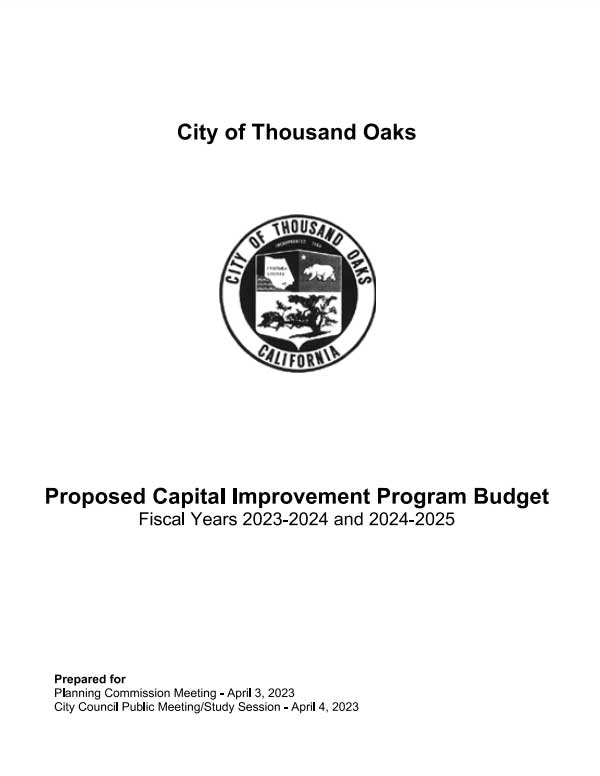The City of Thousand Oaks, located in California, faces several infrastructure challenges, including maintaining its road network and addressing traffic congestion. The city is also working to upgrade and modernize its aging water and sewer systems, ensuring that they can meet the growing demands of the community. Another challenge is the need to improve and expand public transportation options to better serve the city’s residents and reduce reliance on personal vehicles. Additionally, the city is working to upgrade and maintain its parks and recreational facilities to provide safe and enjoyable outdoor spaces for residents.

Sample Highlights from the Capital Improvement Plan
Project ID
Project Title
Project Start Year
Project Description
Project Spend Total
Page Ref
Project Satus
668960
City Hall Lighting Upgrade
2024
“Upgrade light fixtures to LEDs and controllers in City Hall offices
and public areas to smart light fixtures, which control light
operations.”
200000
20
Not Started
668964
Civic Arts Plaza Campus Masterplan Improvements
2024
“Re-examine the uses and activities at the Civic Arts Plaza (CAP),
develop options to create a new town center for public activities,
and make modifications as needed to the building and existing site
to encourage an active downtown area surrounding the CAP.”
21000000
21
Not Started
669045
Heat Pump Installation at Child Care Center
2024
“Installation of energy efficient electric heat pumps to replace
existing packaged air conditioning and heating units at City’s Child
Care Center.”
43
Not Started
669136
Battery Energy Storage at Grant R. Brimhall Library
2024
“Design, construction and installation of battery energy storage
system (BESS) and associated infrastructure at Thousand Oaks
main library to provide resilience and off-grid operation in the event
of a power outage. Priority is to support use of library as an
emergency cooling center and/or shelter.”
1500000
67
Not Started
669144
Electric Vehicle Charging at Grant R. Brimhall Library
2024
“Design and construction of electric vehicle charging infrastructure,
and purchase and installation of charging equipment at the
Thousand Oaks Library in support of public vehicle charging.”
525000
69
Not Started
Explore all options available to you!
Citylitics offers access to over 30,000 unique locations across North America through our Capital Projects Dashboard (CPD).
Capital Projects Dashboard (CPD) provides a comprehensive market view of all planned infrastructure spend in one single view with powerful filters such as: population, project value, fiscal year, project status, project description, geography, and more. The dashboard will help identify opportunity hot spots, create data-driven forecasts you can be confident in with bottom-up data for the next 5 years of planned infrastructure spend, and uncover true market needs.
How to Read a Capital Improvement Plan (CIP) for Business Development?
When a city, municipality or state issues a Capital Improvement Plan (CIP), it can be overwhelming and daunting, but there are a few key things you need to investigate. Let’s start with the definition of CIP – A Capital Improvement Plan (CIP) contains all the individual capital projects, equipment purchases, and major studies for a local government; in conjunction with construction and completion schedules, and in consort with financing plans. The plan provides a working blueprint for sustaining and improving the community’s infrastructures. It coordinates strategic planning, financial capacity, and physical development. A CIP stands at the epicenter of a government’s Planning, Public Works, and Finance departments. When a CIP is issued, it typically includes the following information:
- A listing of the capital projects or equipment to be purchased
- The projects ranked in order of preference
- The plan for financing the projects
- A timetable for the construction or completion of the project
- Justification for the project
- Explanation of expenses for the project
Now, for business development, while the capital plan is interesting, the capital program is for capital expenditures that extends five to ten years beyond the capital budget. Knowing the difference is important so you can influence upcoming program versus just responding to an RFP. If reading the CIP makes your head explode, or you want to save time, Request a Demo of Citylitics CIP dashboard with over 20,000 CIPs from USA and Canada. Citylitics has 20,000 plus available CIPs, how can we help you? What states, cities or counties are you looking to improvement your business development, we can assist you in influencing an upcoming RFP versus simply responding to an RFP. Citylitics Capital Projects Dataset is a comprehensive resource for businesses and organizations looking to track and analyze planned infrastructure spend in their area. The dataset offers a range of features and benefits, including:
- Comprehensive Market View: The dataset provides a single view of all planned infrastructure spend, with powerful filters such as population, project value, fiscal year, project status, project description, geography, and more. This allows businesses to gain a comprehensive understanding of the market and identify new opportunities.
- Identify Opportunity Hot Spots: The dataset offers map views and filters that allow users to identify opportunity hot spots where they need to allocate resources. This helps businesses to understand where they should focus their efforts to achieve the best results.
- Create Data-Driven Forecasts: The dataset provides bottom-up data for the next 5 years of planned infrastructure spend, allowing businesses to create data-driven forecasts they can be confident in.
- Uncover True Market Needs: The dataset allows businesses to develop long-term business plans, R&D, and growth initiatives based on true, bottom-up market needs instead of opinions and anecdotes. This helps businesses to make more informed decisions and achieve better results.
With Citylitics Capital Projects Dataset, businesses can gain a deeper understanding of planned infrastructure spend in their area, which can help them to identify new opportunities and make more informed decisions.
